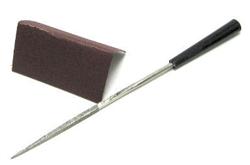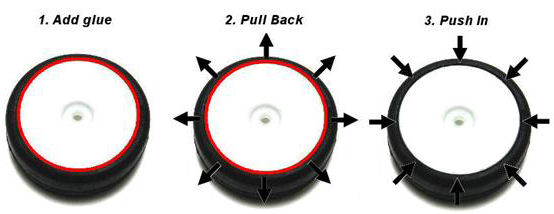
Nexus
Racing Tip: Clamp a standard tire truing arbor to a
pinion gear of the proper size to create a small, portable tire
sander:
When removing the
seams from your tires, the key thing to remember is that you
should not remove too much rubber. The seam should still be
slightly noticeable when you are finished, but it should not be
prominently sticking out from the tire.
Re-gluing
the tires:
Is there
really any point to re-gluing your (pre-glued) spec tires?
Absolutely!
There are two noteworthy reasons for re-gluing your tires in a
competitive racing environment:
The first (and most obvious) reason is for insurance. Though the
few companies that market pre-mounted tires take much pride in
their quality control, you can never be totally sure that the
tires are fully glued. Also, you can never be certain that the
tires were not exposed to extreme temperatures (high heat or
cold that can loosen the bond of the glue) as they made it
through distribution, hobby shops, etc.
The second reason to re-glue is to ensure that the tires run as
"true" as possible. If small areas of the tire bead
are not glued tightly to the rim, these areas can expand away
from the wheel as you run the car on the track, causing the tire
to not be as round (especially at high speeds).
Re-gluing pre-glued tires can seem like overkill.
Sometimes, however, racers make big sacrifices (financial or
other) to attend a racing event. In these situations, it is
certainly worth few minutes of your time to ensure that your
tires do not hold you back.
Process for re-gluing each side of each tire:
First, clean the seam between the tire and rim with a good
cleaner such as rubbing alcohol or motor spray. This will remove
any oils on the sidewall that are leftover from packaging, etc,
so that the CA glue can make a good bond with the tire and wheel.
CA glue selection: It is best to choose a thin CA glue
that is:
-specialized for RC tires (such as Pro-line, Losi, or MuchMore
Racing)
-relatively fresh (If your glue is turning excessively white in
color as it dries, it will have a brittle bond, making it NOT
suitable for gluing tires.)
Next, apply thin CA glue around the seam. Quickly after applying
the glue, pull the sidewall away from the wheel slightly (to
allow the glue to flow into all "vulnerable" crevices
around the bead) and then push the sidewalls back inwards
towards the wheel for several seconds while the glue dries. This
process allows you to get the tightest bond possible.

If you are using
relatively fresh thin glue as recommended, the glue should set
quickly as you push inwards. If it doesn’t, you can place a
thick rubber band around the tire to keep the seam tight while
the glue dries.
Labeling:
Most racing
events that use handout or control spec tires will limit the
amount of sets that each driver can race. In these situations,
it is useful to label all of your tires so that you can
distinguish both from set to set and from tire to tire within
a set (i.e. left or right and front or rear tire).
When you are getting only 1-3 "fast" runs out of
each tire set (the first run usually the fastest), it is
useful to know the following information about each tire:
Which set is it from and how many runs does it have?
This is pretty self explanatory; since typical spec tires will
deteriorate in performance the more they are run, it is ideal
to keep your tires grouped so that you are able to determine
how many runs each tire has.
On which corner of the car was the tire run?
When using spec rubber tires for a limited number of runs, it
is especially important to specify each tire as a "right"
or “left” and consistently run the tire on this particular
side in later runs. This is important because each tire will
"scuff" itself for moving in the forward direction
from either the left or right side when run for the first time.
If you run the tire on a different side in the next race, the
tire will run "loose" for several laps because it
was already scuffed for going in the opposite direction.
Subsequently, as the tires run loose early in the race, they
will likely overheat, which can both cause your car to run
loose for the entirety of the race and add excessive wear to
the tires.
As a result, it
is not recommended to rotate your tires from left to right over
the course of an event.
Tire Strategy
Tip:
Rotating your
rear tires to the front of your car (and installing fresh
tires on the rear), on the other hand, can be a beneficial
tire strategy over the course of a racing event. This
combination will usually run better than if you have a pair of
used tires on both the front and rear. In many situations,
this tire strategy will allow you to have a
consistent-handling car from run to run. All in all, whether
or not this strategy would benefit you depends both on the
number of tire sets that you are allowed to race and the type
of tire used.
In this situation, it is again beneficial to label your tire
sets, because you still need to know which tires came from
which sets so that you do not install the wrong combination on
your car.
Labeling the
tires:
Basically, you
can come up with your own system for labeling your tires. For
example, the phrase "2-RF" could represent the
right-front tire of your second tire set.
The "industrial" or "professional"
versions of the Sharpie permanent marker are great for
labeling your tires, as they are more resistant than other
permanent markers to the types of cleaners and traction
compounds used in RC racing.
One final
note about preparing your spec tires:
Sometimes, no
matter how much effort you put into preparing the tires before
you install them on your car, you will need to give your tires a
quick "scuff" before the race while your car is on the
line. Whether or not (or how much) you will need to do this
depends on how your car is set up. When it is necessary to scuff
at the line, it is best to ensure that you only scuff the
tires in the "forward" direction (in other words,
scuffing the tires by doing donuts at the starting line can do
much more harm than good).
There you have it! After completing these procedures, you will
have organized spec tire sets that are "able" to run
at their full potential. Now, keep in mind that your use of
different traction compounds and warming methods will also
greatly affect the performance of your tires. In fact, these
extra procedures become even more important when everyone is
running the same tires!
Source:

